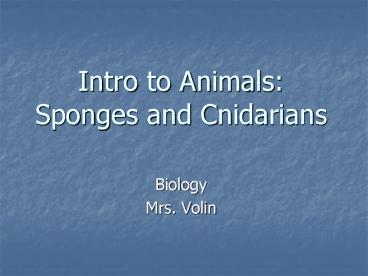Intro to Animals: Sponges and Cnidarians - PowerPoint PPT Presentation
1 / 50
Title:
Intro to Animals: Sponges and Cnidarians
Description:
Sponges, starfish, jellyfish, worms, insects. 5% are vertebrates (have backbone) ... dye ingested and expelled by a giant sponge reveals how it processes huge ... – PowerPoint PPT presentation
Number of Views:282
Avg rating:3.0/5.0
Title: Intro to Animals: Sponges and Cnidarians
1
Intro to AnimalsSponges and Cnidarians
- Biology
- Mrs. Volin
2
Kingdom Animalia
3
Animals
- Multicellular
- Eukaryotes
- Heterotrophic
- Lack cell walls
4
Animals
- 95 are invertebrates (do not have backbone)
- Sponges, starfish, jellyfish, worms, insects
- 5 are vertebrates (have backbone)
- Fish, amphibians, reptiles, birds, mammals
5
Animals Simple to ComplexCharacteristics
- Cell specialization
- Formation of tissues and organs
- Early development
- Blastula protostome or deuterostome
6
(No Transcript)
7
Animals Simple to ComplexCharacteristics
8
(No Transcript)
9
Animals Simple to ComplexCharacteristics
- Cephalization
- The concentration of sense organs at front end of
body - Response to environment is quicker and more
sophisticated - More complexmore cephalization
10
Animals Simple to ComplexCharacteristics
- Body cavity formation
- Fluid filled space where organs are suspended
11
Phylum Porifera---Sponges
- Asymmetrical
- Oceans and freshwater
- Filterfeeders like a water pump
12
(No Transcript)
13
Sponge skeleton spicules calcium or silica in
hard sponges spongin flexible protein fibers
in soft sponges
14
Green dye ingested and expelled by a giant sponge
reveals how it processes huge amounts of seawater
to extract tiny bits of food. Photo (c) Sea
Studios Foundation.
15
A giant sponge
- A giant sponge
16
(No Transcript)
17
Sponge reproduction
- Sexual
- Sperm drift from one sponge to another
- Zygote is motile, then settles on ocean floor
- Asexual
- Reproduce by budding
- Can form gemmules
- Gemmules form when conditions unfavorable
- When conditions become favorable, gemmules grow
into new sponges
18
- Not a sponge
19
Grantia
20
(No Transcript)
21
osculum
spongocoel
Grantia, l.s.
22
Radial canal, opens to inside
Incurrent canal, opens to outside
Ostium, opening of incurrent canal
23
spicules
24
Phylum Cnidaria
25
Phylum Cnidaria
- Class Scyphozoa Jellyfish
- Class Hydrozoa Hydras
- Class Anthozoa Anemones and coral
26
Cnidarians
- Carnivorous
- Stinging tentacles
- Body symmetry
- Specialized tissues
- Soft body
27
Cnidarians
- Cnidocytes stinging cells on tentacles
- for capturing and killing prey
28
Contains paralyzing poison
29
Cnidarians
- Two body forms
- Sessile polyp with tentacles mouth at the top
- Motile medusa with tentacles mouth on the
bottom
30
Cnidarian Life Cycle Polyp and Medusa
gastroderm
motile
sessile
31
Cnidarians
- Feeding
- Paralyzed prey pushed into gastrovascular cavity
with tentacles - Food is digested in the gastrovascular cavity
- Waste leaves body via mouth/anus
- Movement
- Hydrostatic skeleton
- Expand, shrink, contract body
32
Cnidarians
- Respiration by diffusion through body wall
- Waste elimination through body walls
- Response
- Nerve net detects stimuli
- Statocysts determine direction of gravity
- Ocelli (eyespots) detect light
33
Class Scyphozoa Jellyfish
- Live primarily as medusas
- Polyp only as larval stage
- Largest 4 m / Tentacles 30 m
34
Class Hydrozoa Hydras
- Polyps grow in branching colonies 1m or more
- Portuguese man-of-war is a colony with
specialized polyps - One forms a balloon
- Some grow long tentacles
- Some digest food
- Some produce eggs/sperm
35
Hydra
36
Portuguese Man-of-War
The Portuguese Man-of-War is a colony of many
specialized hydras
37
(No Transcript)
38
Class Anthozoa Sea anemones and Corals
- Have only polyp stage (no medusa)
- Central body surrounded by tentacles
- May be colonial (coral reefs)
- Coral reefs take thousands of years to be built
39
Sea anemones Corals
40
Anemone
41
(No Transcript)
42
(No Transcript)
43
(No Transcript)
44
Sea anemone
45
(No Transcript)
46
(gastrovascular cavity)
Coral
47
(No Transcript)
48
(No Transcript)
49
(No Transcript)
50
Elkhorn coral































